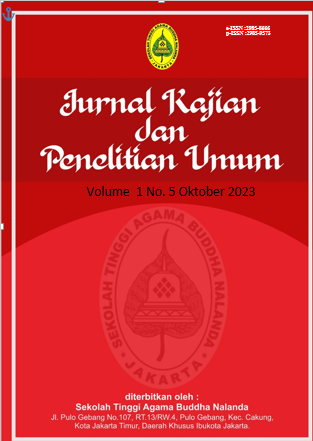Bentuk Penyajian Tari Ngadu Tanduk Di Desa Siulak Panjang Kecamatan Siulak Kabupaten Kerinci Jambi
DOI:
https://doi.org/10.47861/jkpu-nalanda.v1i5.426Keywords:
shape, presentation, hornAbstract
This article aims to analyze the presentation of the Ngadu Horn Dance in Siulak Panjang Village, Siulak District, Kerinci District, Jambi. The type of research used in this study is qualitative research with descriptive methods. The research instrument used in this study was the researcher himself who was assisted by supporting instruments such as stationery, cameras and flash drives. Data collection techniques were carried out by means of literature study, observation, interviews and documentation. Stages of data analysis in the form of data collection, data reduction, data presentation and concluding data. Based on the results of the study, it can be concluded that the presentation of the Ngadu Tanduk Dance in Siulak Panjang Village, Siulak District, Kerinci Regency, Jambi, was held at a wedding reception. This dance is presented to welcome the bride and groom. The form of presentation of the motion includes Representational. The movements consist of worshiping movements, buffalo movements looking for opponents and horn horning movements. The Ngadu Tanduk dance is danced by 2 men, wearing black and gold clothes, Teluk Belango clothes, trousers, songket, belts and laca. The musical instruments used are Dap (tambourine), gong, gong reed, and nyaro (vocals). The presentation of the Ngadu Horn Dance uses a horn property made of bamboo slats measuring about 2 meters which resembles a buffalo horn with a framework wrapped in black, red, yellow and white cloth. The presentation of the Ngadu Tanduk Dance is carried out in an open courtyard with the dancers facing the bride and groom.
References
Adha, Wulandari. (2019). “Estetika Pertunjukan Tari Ngadu Tanduk pada Masyarakat Desa Siulak Panjang Kabupaten Kerinci.” Skripsi. Padang Panjang: Institut Seni Indonesia
Hadi, Y. Sumandiyo. (2003). Seni Dalam Ritual Agama. Yogyakarta: Tarawang Press.
….…….. (2007). Kajian Tari Teks dan Konteks. Yogyakarta: Pustaka Book Publisher.
Indrayuda. (2013). Tari Sebagai Budaya Dan Pengetahuan. Padang : UNP Press.
Moleong, Lexy J. (2014). Metode Penelitian Kualitatif. Edisi Revisi. Bandung: PT Remaja Rosdakarya.
Pakerti, Widya. Metode Pengembangan Seni. Tangerang Selatan: Universitas Terbuka, 2014.
Setiawati, Rahmida. (2008). Seni Tari Jilid II. Depdiknas: Jakarta.
Sedyawati, Edi. (1981). Pertumbuhan Seni Pertunjukan. Jakarta: Sinar Harapan.
Soedarsono. (1978). Tari-tarian Indonesia I. Jakarta: Balai Pustaka.
Sugiyono. (2019). Metode Penelitian Kuantitatif, Kualitatif, dan R&D. Bandung : Alphabet.
Downloads
Published
How to Cite
Issue
Section
License
Copyright (c) 2023 Eza Afrilia, Afifah Asriati

This work is licensed under a Creative Commons Attribution-ShareAlike 4.0 International License.








